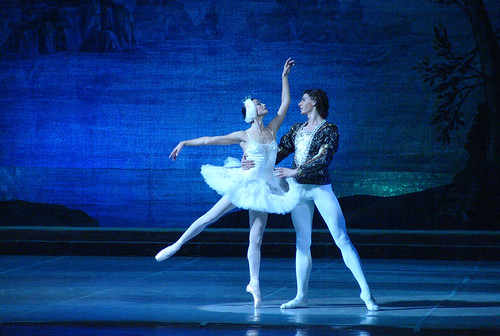The great era of Imperial Russian ballet, crowned by Marius Petipa’s and Lev Ivanov’s transcendent Swan Lake in 1895, is one I can fervently analyze, discuss and simply revel in. French choreographer Petipa almost singlehandedly defined the virtuosic full-length narrative ballet, most notably its structure and grand pas deux (including Odile’s frenzy-generating 32 fouettes). The familiar story, though fantastical, has long provided fodder for intense psychosexual dissection, often with a feminist bent. Understandable - considering the unsettling premise of an evil sorcerer, Von Rothbart, who transforms maidens into swans and holds them captive.
This month director Darren Aronofsky’s movie Black Swan, a heavy-handed tutu thriller starring Natalie Portman as a ballerina about to come unhinged, opened. I generally have mixed feelings about films set in and around ballet studios. I find that more than a few consist of trite plots wrapped around occasionally brilliant flashes of dancing. So with some hesitation, I convinced myself to catch the Portman Black Swan. I left feeling emotionally pummeled…yet fully aware that anyone who lives and works in the dance world would consider much of the film’s overwrought theatrics laughable. Aronofsky does more than dissect the famed avian ballet. He plucks its soft feathers, peels away its delicate skin (quite literally) via Portman’s obsessive self-mutilation, then slices and dices any and all Romantic trappings. Petipa and Ivanov would no doubt be amused and annoyed.
In a strange way Aronofsky’s eviscerating, melodramatic take is not a total flop. But the graphic depictions of blistered and broken toes, eating disorders, ruthless competition, and unforgiving falls from stardom would crush the dreams of the most dedicated aspiring ballerina. In Black Swan, Portman’s Nina caves under the pressure of taking on the role of Odette/Odile against a demanding director (an affected and clichéd Vincent Cassel), her overprotective mother (Barbara Hershey practically plumbing the creepy depths of Piper Laurie in Carrie) and a potential rival (Mila Kunis as the ambiguous Lily). Not surprisingly, the film has been compared to the 1948 classic, The Red Shoes (with Moira Shearer torn between love and career), and The Turning Point, the beloved 1977 Shirley MacLaine-Anne Bancroft sparring match loosely based on American Ballet Theatre.
And that’s where I disagree. Aronofsky’s Black Swan cannot be measured against other dance films, because it’s not about dance at all. Even the close ups of Portman earnestly fluttering her arms are unconvincing. ABT’s Sarah Lane served as Portman’s dance double. Unfortunately, we see very little of Lane’s poetic grace. But, again, it’s basically a moot point. That’s because Black Swan is really an unnerving visual embodiment of paranoia that just happens to use the more masochistic elements of ballet to heighten the effect. The director – together with writers Mark Heyman, Andres Heinz and John McLaughlin – take as their jumping-off point the intriguing dualities of Odette (the White Swan) and Odile (the Black Swan). They pit the innocent/ethereal qualities of one against the carnal/treacherous sensibilities of the other so that both are at war within Portman’s psychologically ravaged, suicidal woman-child Nina. It’s a shattering portrayal...and, despite Black Swan’s inherent All About Eve-esque ballet clichés, I found Aronofsky’s greatest success not in saying anything profound about ballet but in crafting one of the most bone-chilling cinematic manifestations of self-destructive behavior no matter what the profession.
 Lucia Mauro is an arts writer and dance critic for several publications, as well as WBEZ-Chicago Public Radio. She is an adjunct professor of dance history at Loyola University Chicago; moderates the Auditorium Theatre's FireSide Chats; and will be presenting a series of Auditorium Theatre-sponsored lectures, titled "Milestones in Dance History: From Early Court Ballets to Sergei Diaghilev's Ballets Russes," March 8-April 5, 2011 at Roosevelt University. |


No comments:
Post a Comment